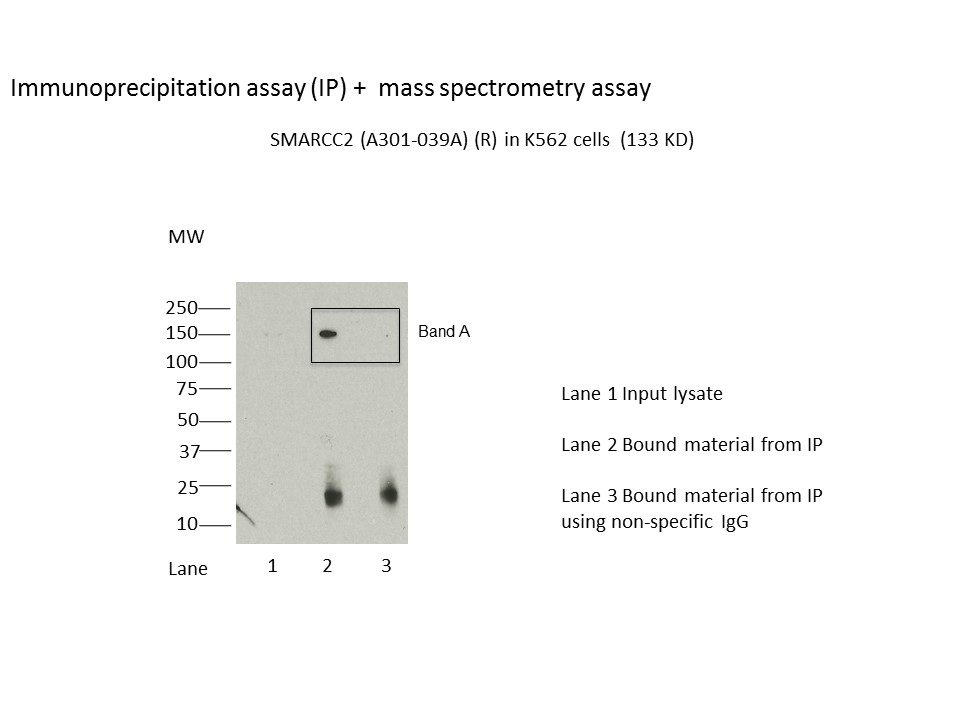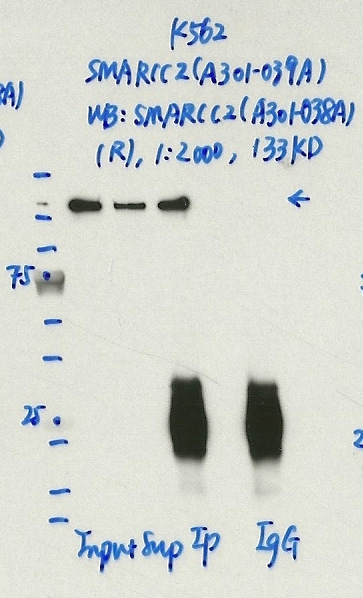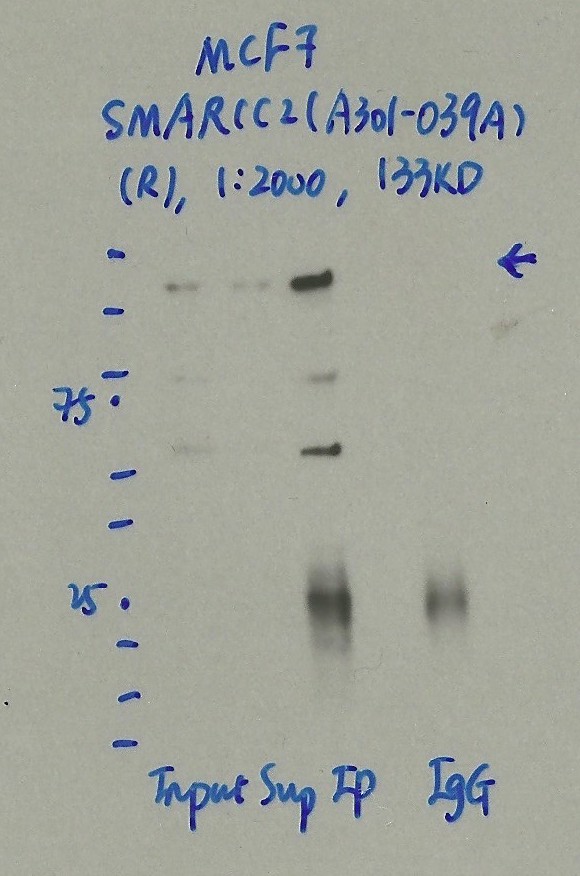ENCAB313DWJ
Antibody against Homo sapiens SMARCC2
Homo sapiens
K562, HepG2, MCF-7
characterized to standards with exemption
- Status
- released
- Source (vendor)
- Bethyl Labs
- Product ID
- A301-039A
- Lot ID
- 1
- Characterized targets
- SMARCC2 (Homo sapiens)
- Host
- rabbit
- Clonality
- polyclonal
- Purification
- affinity
- Aliases
- michael-snyder:AS-1286
- External resources
Characterizations
SMARCC2 (Homo sapiens)
K562
compliant
- Caption
- Immunoprecipitation was performed on nuclear extracts from the cell line K562 using the antibody A301-039A. Lane 1: input nuclear lysate. Lane 2: material immunoprecipitated with antibody. Lane 3: material immunoprecipitated using control IgG. Marked bands were excised from gel and subjected to analysis by mass spectrometry. Target molecular weight: 132.879.
- Submitted by
- Nathaniel Watson
- Lab
- Michael Snyder, Stanford
- Grant
- U54HG006996
- Download
- #1031 SMARCC2(301-039A)-1.jpg
SMARCC2 (Homo sapiens)
K562
compliant
- Caption
- Immunoprecipitation was performed on nuclear extracts from the cell line: K562, using the antibody A301-039A. The blot shows western blot analysis of input, flowthrough, immunoprecipitate and mock immunoprecipitate using IgG.
- Reviewer comment
- +20% allows up to 159.6kD size be tolerated.
- Submitted by
- Denis Salins
- Lab
- Michael Snyder, Stanford
- Grant
- U54HG006996
- Download
- 1050_4_SMARCC2_A301-039A.jpg
SMARCC2 (Homo sapiens)
HepG2
compliant
- Caption
- Immunoprecipitation was performed on nuclear extracts from the cell line: HepG2 using the antibody A301-039A. The image shows western blot analysis of input, flowthrough, immunoprecipitate, and mock immunoprecipitate using IgG. Target molecular weight: 132.879.
- Reviewer comment
- Marked band is higher than expected size but within allowed 20% deviation and is consistent with pattern in other cell lines.
- Submitted by
- Nathaniel Watson
- Lab
- Michael Snyder, Stanford
- Grant
- U54HG006996
- Download
- 3.jpg
SMARCC2 (Homo sapiens)
Method: immunoprecipitation followed by mass spectrometry
exempt from standards
- Caption
- IP followed by mass spectrometry. Briefly, protein was immunoprecipitated from K562 nuclear cell lysates using the antibody A301-039A, and the IP fraction was loaded on a 10% polyacrylamide gel (NuPAGEBis-Tris Gel) and separated with an Invitrogen NuPAGE electrophoresis system. The gel was stained by ColloidialCoomassie G-250 stain, gel fragments corresponding to the bands indicated were excised. Then proteins were trypsinized using the in-gel digestion method. Digested proteins were analyzed on an Orbitrap Elite mass spectrometer (Thermo Scientific) by the nanoLC-ESI-MS/MS technique. Peptides were identified by the SEQUEST algorithm and filtered with a high confidence threshold (Peptide false discovery rate < 1%, 2 unique peptides per protein minimum, mass error < 10 ppm).
- Submitter comment
- ARID1A, SMARCA4, ARID1B, SMARCC1, SMARCA2 and SMARCC2 are component of the BAF complex, http://www.genecards.org/cgi-bin/carddisp.pl?gene=SMARCC2&keywords=smarcc2. Both HNRNPUL1 (96KD) and SMARCC2 have interaction with BRD7(74KD), http://thebiogrid.org/112485/summary/homo-sapiens/smarcc2.html and http://thebiogrid.org/116281/summary/homo-sapiens/hnrnpul1.html. But BRD7 is not in the gel slice with HNRNPUL1 and SMARCC2. DSP involves poly(A) RNA binding and structural constituent of cytoskeleton. NUP210 is not a DNA binding protein. ARID2 and SMARCC2 have interaction, 3 publications on http://thebiogrid.org/112485/summary/homo-sapiens/smarcc2.html. Both JUP and SMARCCA2 has interaction with EED (50KD), http://thebiogrid.org/112485/summary/homo-sapiens/smarcc2.html and http://thebiogrid.org/109931/summary/homo-sapiens/jup.html. PBRM1 and EWSR1 have interactions with SMARCC2, http://thebiogrid.org/112485/summary/homo-sapiens/smarcc2.html. ALB involves enzyme binding and chaperone binding. AZGP1 involves antigen binding and peptide antigen binding. ANXA2 involves poly(A) RNA binding and Rab GTPase binding.
- Reviewer comment
- Although SMARCC2 is not the top ranked TF, higher ranked TFs are part of the BAF complex with SMARCC2 as argued by the submitters (PMID: 20550931).
- Submitted by
- Nathaniel Watson
- Lab
- Michael Snyder, Stanford
- Grant
- U54HG006996
SMARCC2 (Homo sapiens)
MCF-7
compliant
- Caption
- Immunoprecipitation was performed on nuclear extracts from the cell line: MCF-7 using the antibody A301-039A. The image shows western blot analysis of input, flowthrough, immunoprecipitate, and mock immunoprecipitate using IgG. Target molecular weight: 132.879.
- Reviewer comment
- Marked band is higher than expected size but within allowed 20% deviation and is consistent with pattern in other cell lines.
- Submitted by
- Nathaniel Watson
- Lab
- Michael Snyder, Stanford
- Grant
- U54HG006996



